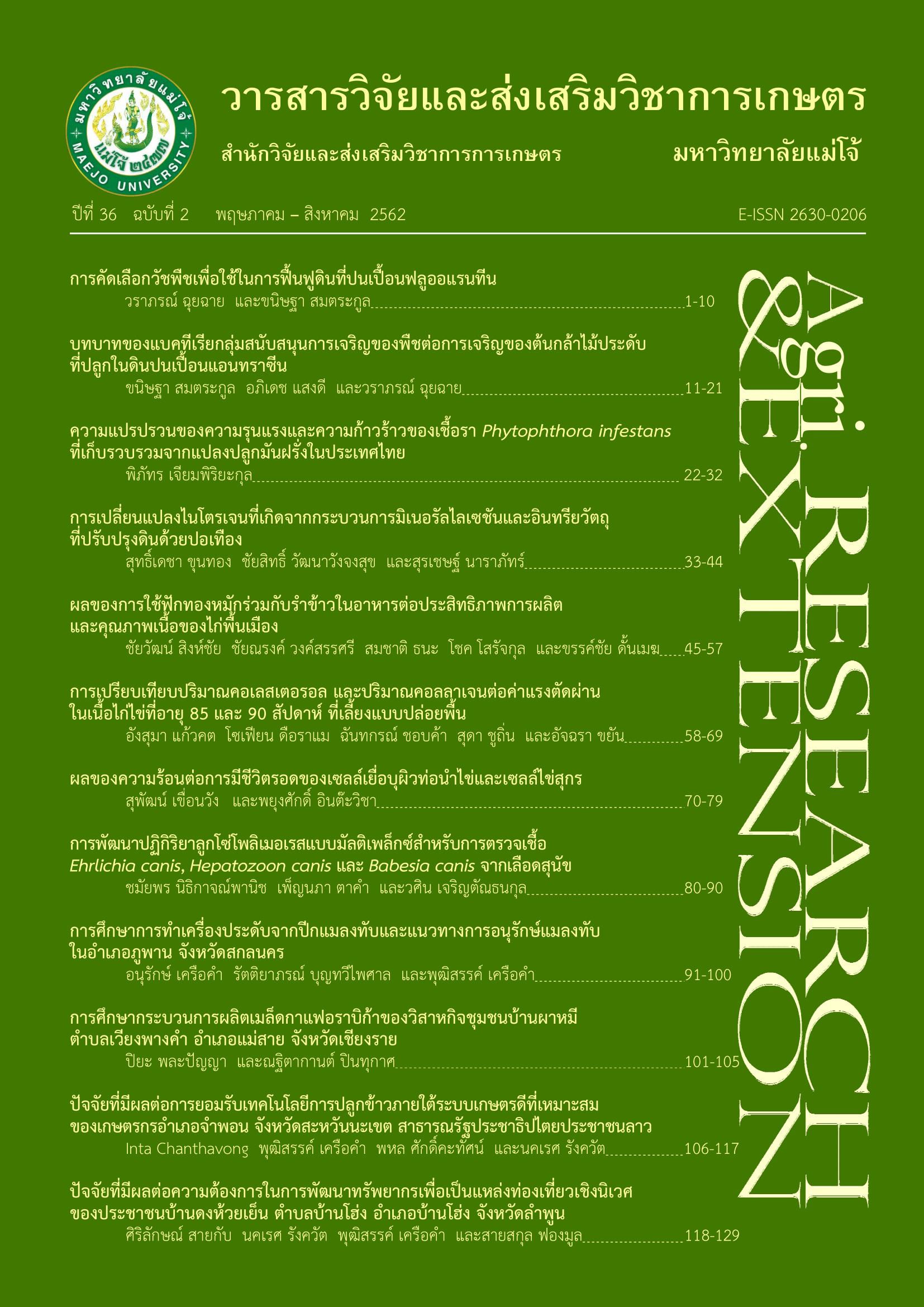ปัจจัยที่มีผลต่อการยอมรับเทคโนโลยีการปลูกข้าวภายใต้ระบบเกษตรดีที่เหมาะสม ของเกษตรกรอำเภอจำพอน จังหวัดสะหวันนะเขต สาธารณรัฐประชาธิปไตยประชาชนลาว
คำสำคัญ:
การยอมรับ, เทคโนโลยีการปลูกข้าว, เกษตรดีที่เหมาะสม, จังหวัดสะหวันนะเขตบทคัดย่อ
การวิจัยในครั้งนี้มีวัตถุประสงค์ในการศึกษา คือ 1) ข้อมูลพื้นฐานส่วนบุคคล เศรษฐกิจ และสังคมของเกษตรกร 2) ระดับการยอมรับเทคโนโลยีการปลูกข้าวภายใต้ระบบเกษตรดีที่เหมาะสม 3) ปัจจัยที่มีผลต่อการยอมรับเทคโนโลยีการปลูกข้าวภายใต้ระบบเกษตรดีที่เหมาะสม และ 4) ปัญหา และข้อเสนอแนะเกี่ยวกับการปลูกข้าวภายใต้ระบบเกษตรดีที่เหมาะสม เก็บรวบรวมข้อมูลจากกลุ่มตัวอย่าง จำนวน 267 คน โดยใช้แบบสอบถาม วิเคราะห์ข้อมูลโดยใช้สถิติพรรณนา เพื่อหาค่าความถี่ ค่าร้อยละ ค่าเฉลี่ย ส่วนเบี่ยงเบนมาตรฐาน และการวิเคราะห์ปัจจัยที่ส่งผลต่อการยอมรับเทคโนโลยีการปลูกข้าวโดยสถิติถดถอยพหุคูณแบบคัดเลือกเข้า
ผลการวิจัยพบว่า ร้อยละ 64 ของเกษตรกรเป็นเพศชาย มีอายุเฉลี่ย 51.45 ปี เกือบทั้งหมดมีสถานภาพสมรสแล้ว เกษตรกรมากกว่าครึ่งมีการศึกษาอยู่ในระดับชั้นประถมศึกษาหรือต่ำกว่า มีสมาชิกในครัวเรือนเฉลี่ย 6.82 คน มีแรงงานในครัวเรือนเฉลี่ย 3 คน มีพื้นที่ทำการเกษตรเฉลี่ย 3.88 ไร่ มีประสบการณ์ในการทำเกษตรกรรมเฉลี่ย 31.83 ปี มีรายได้รวมในครัวเรือนเฉลี่ย 41,396 บาทต่อปี เกษตรกรมีความรู้ความเข้าใจเกี่ยวกับการปลูกข้าวภายใต้ระบบเกษตรดีที่เหมาะสมอยู่ในระดับมาก โดยภาพรวมเกษตรกรมีการยอมรับเทคโนโลยีการปลูกข้าวภายใต้ระบบเกษตรดีที่เหมาะสม รวมทุกด้านอยู่ในระดับน้อย ปัจจัยที่มีผลต่อการยอมรับเทคโนโลยีการปลูกข้าวภายใต้ระบบเกษตรดีที่เหมาะสม มี 5 ปัจจัย ได้แก่ ระดับการศึกษา จำนวนครั้งของการติดต่อกับเจ้าหน้าที่ ช่องทางการรับรู้ข้อมูลข่าวสาร การรับรู้ข้อมูลข่าวสารด้านการเกษตร และปัจจัยด้านความรู้ความเข้าใจเกี่ยวกับการปลูกข้าวภายใต้ระบบเกษตรดีที่เหมาะสม ด้านปัญหาของการปลูกข้าวภายใต้ระบบเกษตรดีที่เหมาะสม พบว่าเกษตรกรมีปัญหาเรื่องการไม่ยอมรับเทคโนโลยีที่สมัยใหม่มาใช้ในการผลิต ปัญหาน้ำไม่เพียงพอต่อการผลิต ปัญหาดินขาดความอุดมสมบูรณ์ ปัญหาผลผลิตข้าวได้รับความเสียหายจากภัยพิบัติทางธรรมชาติ ปัญหาการระบาดของโรคและแมลงศัตรูพืช ดังนั้นผู้วิจัยจึงมีข้อเสนอแนะดังนี้ เนื่องจากเกษตรกรมีการยอมรับเทคโนโลยีการปลูกข้าวอยู่ในระดับน้อย เจ้าหน้าที่ส่งเสริมการเกษตรต้องออกส่งเสริมอย่างต่อเนื่อง เพื่อสนับสนุนองค์ความรู้หรือวิทยาการสมัยใหม่ในการปลูกข้าวให้แก่เกษตรกร เพื่อทำให้เกษตรกรเห็นได้ถึงความสำคัญของการใช้เทคโนโลยีที่ทันสมัยในการผลิตข้าว
เอกสารอ้างอิง
Akudugu, M.A., E. Guo and S.K. Dadzie. 2012. Adoption of modern agricultural production technologies by farm households in Ghana: what factors influence their decisions?. Journal of Biology, Agriculture and Healthcare 2(3): 1-14.
Champhone’s Agriculture and Forestry Office. 2018. Annual report on agriculture and forestry practices in 2017. Champhone: Agriculture and Forestry Office. 17 p.
Department of Agronomy. 2014. Good Agricultural Practices Standard for Rice Production in Laos. Vientiane: State Printing. 65 p.
Khemmee, P., S.K. Sanserm and B. Yooprasert. 2013. Farmer Adoption of Parachute Rice Planting Technology in Bang Rakum District of Phitsanulok Province. Nonthaburi: Sukhothai Thammathirat Open University. 13 p.
Kristry, D. 1984. Principle of Agricultural Extension Method. Bangkok: Thai Watlana Panit Publishing Co.,Ltd. 250 p.
Lao Statistics Bureau. 2015. Statistics Yearbook 2015. Vientiane: Lao PDR. 230 p.
Lapple, D. and T.V. Rensburg. 2011. Adoption of Organic Farming: Are There Differences between Early and Late Adoption. Amsterdam: Elsevier. 9 p.
Ministry of Agriculture and Forestry. 2017. Expanding Clean Agriculture Production to Supply Market Demands Together with Improved International Market Access can Serve to Catalyse Growth in the Lao Organic Produce Sector. Vientiane: Department of Agronomy. 56 p.
Ministry of Planning and Investment. 2016. 8th Five-Year National Socio-Economic Development Plan (2016–2020). Vientiane: Lao PDR. 253 p.
Mwangi, M. and S. Kariuki. 2015. Factors determining adoption of new agricultural technology by smallholder farmers in developing countries. Journal of Economics and Sustainable Development 6(5): 208-217.
Painvijite, K. 2011. Application of Organic Rice Production Technology by Farmers in Phayakkhaphum Phisai District, Maha Sarakham Province. Nonthaburi: Sukhothai Thammathirat Open University. 15 p.
Rahul, P., P.Tongdeelert and S. Rangsipaht. 2013. Factors Relating to Decision Making on Para Rubber Cultivation of Farmers in Sanam Chai Khet District, Chachoengsao Province. Bangkok: Kasetsart University. 10 p.
Sacklokham, S. 2013. Rice based farming systems in Lao PDR: opportunities and challenges for food security. Vientiane: Faculty of Agriculture, National University of Laos, Lao PDR. 9 p.
Saosama, T., S. Yotakhong and S. Seesang. 2010. Factors Affecting the Adoption of Good Quality Hom Mali Rice Production Adhering to Good Agricultural Practice of Farmers in Borabue District of Maha Sarakham Province. Nonthaburi: Sukhothai Thammathirat Open University. 13 p.
Sawathee, P. 1998. Sampling method for research. NIDA Development Journal 38(3): 103-130.
Sujaritturakarn, W. 2010. Factors Influencing the Adoption of Production Techniques and Application of Organic Fertilizer among Agriculturists in Hatyai District, Songkhla Province. Songkhla: Prince of Songkla University. 116 p.
Sunthophan, S. 2009. Farmer’s Adoption of Organic Production Technology System of Mango Orchards in Phrao District. Chiang Mai: Maejo University. 132 p.
Wattanasangsuth, W. 2011. Determinants of Nuclear Technology Adoption through Irradiation for Agriculture in Thailand. Bangkok: Thammasart University. 222 p.
Yamane, T. 1973. Statistics: An Introductory Analysis. New York: 3.S.l. Harper International. 886 p.
ดาวน์โหลด
เผยแพร่แล้ว
รูปแบบการอ้างอิง
ฉบับ
ประเภทบทความ
สัญญาอนุญาต

อนุญาตภายใต้เงื่อนไข Creative Commons Attribution-NonCommercial-NoDerivatives 4.0 International License.
บทความนี้ได้รับการเผยแพร่ภายใต้สัญญาอนุญาต Creative Commons Attribution-NonCommercial-NoDerivatives 4.0 International (CC BY-NC-ND 4.0) ซึ่งอนุญาตให้ผู้อื่นสามารถแชร์บทความได้โดยให้เครดิตผู้เขียนและห้ามนำไปใช้เพื่อการค้าหรือดัดแปลง หากต้องการใช้งานซ้ำในลักษณะอื่น ๆ หรือการเผยแพร่ซ้ำ จำเป็นต้องได้รับอนุญาตจากวารสาร





